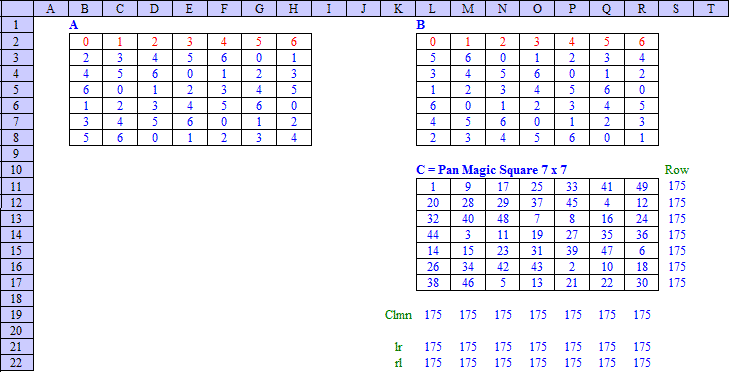Office Applications and Entertainment, Magic Squares | ||
|
|
Index | About the Author |
|
7.0†††Magic Squares (7 x 7)
Pan Magic Squares of order 7 can be represented as follows:
As the numbers a(i), i = 1 ... 49, in all rows, columns and diagonals sum to the same constant this results in following linear equations:
a( 1) + a( 2) + a( 3) + a( 4) + a( 5) + a( 6) + a( 7) = s1
Or in matrix representation:
Which can be reduced, by means of row and column manipulations, to:
a(43) = s1 - a(44) - a(45) - a(46) - a(47) - a(48) - a(49)
The linear equations shown above, are ready to be solved, for the magic constant 175.
0 < a(i) =< 49††††††††for i = 1, 2 ... 22, 29, 36 and 43
An optimized guessing routine (MgcSqr7a) produced, with a careful variation of the independent variables, 16 Magic Squares within 11 minutes, which are shown in Attachment 7.1.1.
7.2†††Sudoku Comparable Method
More successfully, Pan Magic Squares of order 7 can be constructed by means of following Sudoku Comparable Method:
Which can be realized by means of an Excel spreadsheet as shown below: |
|
The applicable Sudoku Comparable Squares described above, generated with routine SudSqr7a in 150 seconds (4 x 37,5), are shown in Attachment 7.3.4.
7.3†††Further Analysis, Ultramagic Squares
Ultra Magic Squares can be defined as a Symmetric Pan Magic Squares.
This results in following additional equations:
which can be added to the equations describing a Pan Magic Square of the 7th order (Section 7.1), and results in following linear equations: a(43) = 175 - a(44) - a(45) - a(46) - a(47) - a(48) - a(49) a(36) = 175 - a(37) - a(38) - a(39) - a(40) - a(41) - a(42) a(35) = 150 - a(41) - a(42) - a(47) - a(48) - a(49) a(34) = a(35) + a(37) - a(40) + a(44) + a(45) - a(46) - a(48) a(33) = 150 + a(38) - a(39) - a(40) - a(41) + a(44) - 2 * a(47) - a(48) - a(49) a(32) = 150 - a(38) - a(40) - a(44) - a(46) - a(48) a(31) = 300 - a(33) - a(37) - 2 * a(39) - a(41) - a(43) - 2 * a(45) - 2 * a(47) - a(49) a(30) = -200 + a(39) + a(40) + 2 * a(41) + a(42) - a(44) + 2 * a(47) + 2 * a(48) + a(49) a(29) = -200 + a(38) + a(39) + a(40) + a(41) + a(42) + a(46) + a(47) + a(48) + a(49) a(28) = 25 - a(37) + a(41) - a(44) - a(45) + a(47) + a(48) a(27) = -325 + a(39) + 2 * a(40) + 2 * a(41) + 2 * a(42) - a(44) - a(45) + a(46) + 3*a(47) + 3*a(48) + 2*a(49) a(26) = a(27) + a(36) - a(42) + a(45) - a(47) a(25) = 25
An optimized guessing routine (Priem7c) produced,
with a(49) = 1, a(48) = 9 and a(47) = 27, 531 Ultra Magic Squares within 3,25 hrs,
which are shown in Attachment 7.4.1.
7.3.2†Sudoku Comparable Method
Comparable with the method described in Section 7.2 above, also
any Ultra Magic Square M of order 7 - based on the distinct integers 1 ... 49 -
can be written as
M =
B1 +
7 * B2 +
[1]
Each 7th order Ultra Magic Square corresponds with miscellaneous other Ultra Magic Squares which can be obtained by means of transformations as described below:
Based on this set of transformations and the eight squares which can be found by means of rotation and/or reflection, any 7th order Ultra Magic Square corresponds with a Class of 8 * 12 = 96 Ultra Magic Squares (ref. Attachment 7.2.4).
In following Ultra Magic Square, previously published as a part of Walter Trumpís detailed study regarding Ultra Magic Squares of order 7, all 3-cell patterns sum to 75 (= 3 * 25).
The equations describing Ultra Magic Squares with this additional property can be written as: a(47) = 75 - a(48) - a(49) a(43) = 100 - a(44) - a(45) - a(46) a(40) = 75 - (2*a(41) + a(42) + a(46) + a(48) - a(49))/2 a(38) = 75 + a(39) - a(40) - a(44) - a(48) a(37) = 75 - a(44) - a(45) a(36) = 25 - 2 * a(39) - a(41) - a(42) + 2 * a(44) + a(45) + a(48) a(35) = 75 - a(41) - a(42) a(34) = a(40) + a(41) - a(49) a(33) = -75 + a(41) + a(42) + a(46) + a(48) a(32) = 75 - a(39) - a(46) a(31) = 50 - 2 * a(39) - 2 * a(41) - a(42) + 2 * a(44) + a(48) + a(49) a(30) = 25 + a(38) - a(46) a(29) = -50 + 2 * a(39) + a(41) + a(42) - a(44) + a(46) - a(48) a(28) = 25 + a(41) - a(49) a(27) = 50 + a(39) + a(42) - a(44) - a(45) - a(48) a(26) = - a(39) - a(41) - a(42) + a(44) + a(45) + a(48) + a(49) a(25) = 25
with the independent variables a(39), a(41), a(42), a(44), a(45), a(46), a(48) and a(49).
As a part of the study mentioned in Section 7.3.4 above, Walter introduced many other Special Ultra Magic Squares, amongst others Inlaid Magic Squares as discussed in Section 7.6.4 thru 7.6.9.
|
|
|
Index | About the Author |
